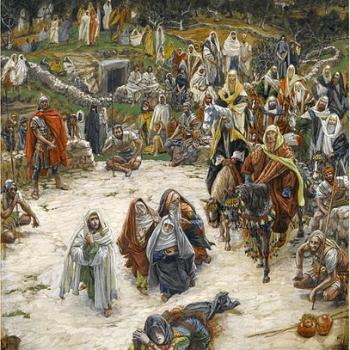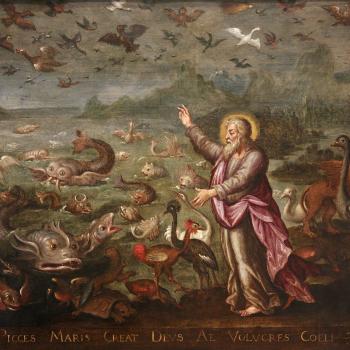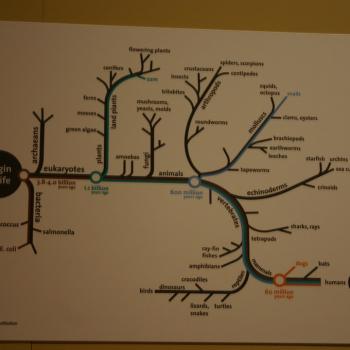
In the medieval collection detailing the lives of the saints, The Golden Legend, there is a story about St. Jerome in which he and his monastery brethren befriend a lion. The lion came to the monastery with a hurt paw. While many of the monks fled from its sight, afraid of what the lion might do, St. Jerome went up to it and welcomed it as if it were a guest of the monastery. He had several of the monks take care of the lion, cleaning its feet and removing a thorn which had been in its paw. The lion was more than grateful: it settled in with the monastery, becoming a welcome member of its community, and like a member of the community, it was eventually given its own task:
By this time, Jerome sensed that the Lord had not sent them the lion for the health of the wounded paw, but so that the animal could render them some service. The saint therefore followed the advice of his monks and assigned a duty to the lion. The monks had an ass that carried firewood in from the forest, and it became the lion’s chore to lead the ass out to pasture and to watch over her safety. And so it went. One the care of the ass was enjoined upon the lion, they were constant companions. [1]
According to the story, at one time some merchants found the lion and the ass together, and captured the ass; many of the monks assumed the lion had done something to the ass and punished it, which the lion is said to have taken with much humility. Sometime afterwards, the lion, out in the fields, saw the merchants with many animals in their caravan, including the ass which had been stolen; the lion ran up to the animals, and herded them back to the monastery. When Jerome saw them coming, he had the monks get ready to feed them all. The merchants eventually came to the monastery, admitted their fault, and were given admonishment by Jerome before they decided to pay back their debt to the monastery while asking Jerome for his blessing. The lion, of course, had vindicated himself and was shown to be innocent of any wrongdoing and he had his companion, the ass, back with him after that.
While the legend about St. Jerome and the lion seems fanciful, perhaps borrowing a little from old fables, its acceptance into the lore around St. Jerome tells us something about the way medieval Christians viewed the kind of relationship humans should have with animals by showing the way saints interacted with them. Far from seeing them as hostile forces to be destroyed, saints constantly showed Christians that animals could and should somehow intermingle with human society, becoming a part of the community. Thus, similar to what we read with St. Jerome, the story of St. Francis with the Wolf of Gubbio indicated that Francis was able to make a wild wolf a member of the greater community, a beloved animal companion who was mourned the day it died.
Saints, because of their holiness, are often understood as participating in and demonstrating various ideals which humanity had lost due to sin. Through grace, they had come to experience, at least in part, the glory of the eschaton, as St. Symeon the New Theologian explained:
As many therefore as are children of the light also become sons of the Day which is to come, and are enabled to walk decently as in the day. The Day of the Lord will never come upon them, because they are already in it forever and continually. The Day of the Lord, in effect, is not going to be revealed to those who are ever illumined by the divine light, but for those who are in the darkness of the passions and spend their lives in the world hungering for things of the world, for them it will be fearful and they will experience it as an unbearable fire. [2]
It is not that all saints share in the same charism, in the same ideals, nor that all that the saints did were ideal, however the best part of their lives, the best part of their character, represents something for us to consider and imitate. The worst part of their lives, to be sure, should be understood for how bad it was, so that we do not imitate them in their sins. What is important is the positive content of their lives. Thus, many saints, like Jerome, like Francis of Assisi, were known to have special relationships with animals, a relationship best represents the companionship humans were expected to have with animals but lost it due to their sin. They could mollify animals, turning them away from destructive behavior, as St. Anthony the Great was shown to do:
Later, when he saw that people were coming to him again, he raised a few vegetables also, that the visitors might have some little refreshment after the weariness of that hard journey. At first, however, the beasts in the desert often used to damage his crop and his garden when they came for water, but, having caught one of them, he said graciously to all: ‘Why do you harm me when I do you no harm? Go away, and, in the name of the Lord, do not come near these things any more.’ After that, as if fearing his command, they no longer came near the place.[3]
St. Anthony, in another story, was helped by lions to bury St. Paul the Hermit in the desert, showing how saints not only pacified so-called wild beasts but for ways to work with and interact with them:
While he was entertaining such thoughts, behold, there came rushing from the interior of the wilderness two lions with the manes flowing about their necks. At the first sight of them, he was thoroughly frightened, but, turning his thoughts back to God, he remained as undaunted as if he were looking at doves. They dashed directly to the body of the blessed old man, stopped short, wagging their tails, and dropped down at his feet, roaring with mighty roars to communicate their grief in the only way they could. Then, not far from the corpse, they began to scratch the ground with their paws; vigorously scooping away sand, they dug out a space that would hold the body of a man. Straightway, as if demanding a reward for their work, with heads hanging but ears twitching, they made for Anthony and began to lick his hands and feet. He understood that they were merely begging a blessing from him. [4]
The destructive behavior we see coming from animals, especially in relation to humanity, often come from our mistreatment of them. When we take over their habitats, animals react accordingly. Holy saints, on the other hand, try to find some sort of balance; they know they have entered the homes of animals, and so treat them with respect, expecting such animals to treat them with respect in return. St. Seraphim of Sarov is famous for his relationship and friendship with bears. Nonetheless, when a bear interrupted St. Seraphim’s dialogue with nuns, he asked why the bear had come to scare his guests, and then go out and find some gift to bring to the nun so as to compensate her for the fear it had brought her interrupting them as it did. The bear did as it was told, bringing honeycomb as his peace offering[5] At other times, other visitors would see the care and concern St. Seraphim showed for bears, indicating that he had a great friendship with them.
Of course, what a saint did with particular animals often depended upon the circumstances in which they encountered them. St. Anthony of Padua could preach to the fish because they came close to the shore, seemingly interested in what he had to say (putting to shame Anthony’s critics). St. Brigit could bless a boar and hide it from hunters. St Martin of Porress established an animal shelter for stray cats and dogs. What is common in all their stories is the care and concern they had for animals, knowing that their livelihood and freedom was important. Thus, we read of St. Francis how he often would set loose various animals, like birds, which had been turned over to him:
Hearing to the hermitage of Greccio, blessed Francis was crossing the lake of Rieti in a small boat. A fisherman offered him a little water-bird so he might rejoice in the Lord over it. The blessed Father received it gladly, and with open hands, gently invited it to fly away freely. But the bird did not want to leave: instead it settled down in his hands as in a nest, and the saint, his eyes lifted up, remained in prayer. Returning to himself as if after a long stay in another place, he sweetly told the little bird to return to its original freedom. And so the bird, having received permission with a blessing, flew away expressing its joy with the movement of its body.[6]
There are countless examples of the saints, showing concern for their wellbeing; it was a part of who they were, and what made them great. We should, like them, find ourselves concerned with animals, not only overturning the harm we have done to them, but to lift them up and bless them. We should see them as companions in the world, as well as companions on the way towards eternity. Scripture talks about them praising God, showing that in some form or another, perhaps in a way known only to them, they connect with God and rejoice in his grace. Saints, who have a better sense of the kingdom of God, who see and understand how it is found in the whole world even as it is found in themselves, are capable of witnessing that glory in all things, including and especially animals. But is this surprising? Do they not have the best example with Jesus Christ himself who, in his birth, found himself in a manger, in a setting set for animals, blessing them with his presence? We see the kingdom God in his nativity, and with it, we see a type of the eschatological kingdom, where humanity is one with their animal brethren at the feet of Christ himself.
[1] Jacobus de Voragine, The Golden Legend. Volume II. Trans. William Granger Ryan (Princeton: Princeton University Press, 1993), 213-4.
[2] St. Symeon the New Theologian. “Tenth Ethical Discourse” in On the Mystical Life: The Ethical Discourses. Volume 1: The Church and the Last Things. Trans. Alexander Golitzin (Crestwood, NY: St. Vladimir’s Seminary Press, 1995), 146-7.
[3] St. Athanasius, “Life of St. Anthony” in Early Christian Biographies. Trans. Roy J. Deferrari et. al. Ed. Roy J. Deferrari (Washington, DC: CUA Press, 1952; rep. 1992), 181.
[4] St. Jerome. “Life of St. Paul the Hermit” in Early Christian Biographies. Trans. Roy J. Deferrari et. al. Ed. Roy J. Deferrari (Washington, DC: CUA Press, 1952; rep. 1992), 236.
[5] See Lazarus Moore, St. Seraphim of Sarov: A Spiritual Biography (Blanco, Texas: New Sarov Press, 1994),160-2.
[6] Thomas of Celano, “The Remembrance of the Desire of a Soul” in Francis of Assisi: The Founder. Ed. Regis Armstrong, OFM, J.A. Wayne Hellman, OFM Conv., and William J. Short, OFM. (New York: New City Press, 2000), 355.
Stay in touch! Like A Little Bit of Nothing on Facebook.
If you liked what you read, please consider sharing it with your friends and family!

















